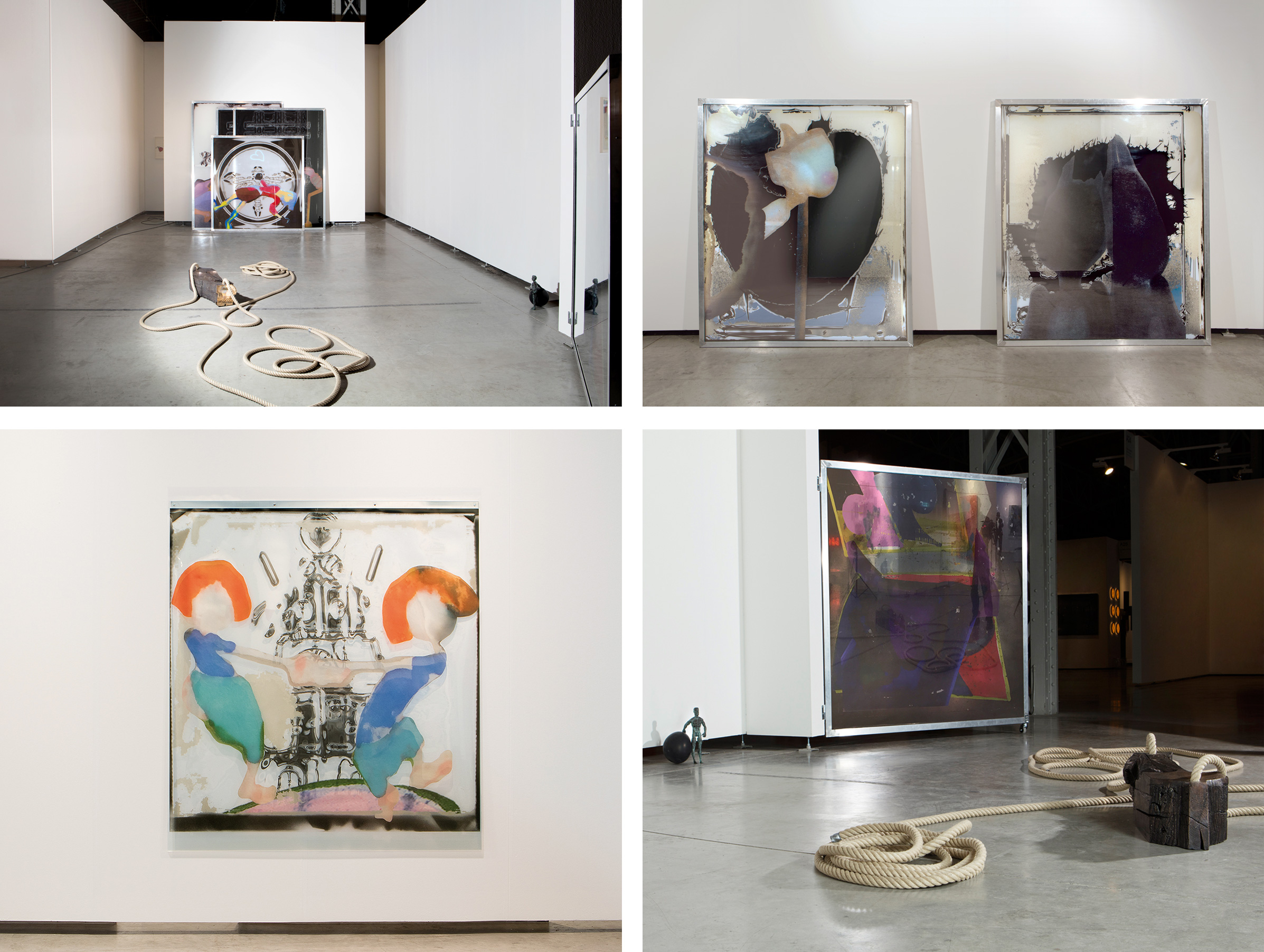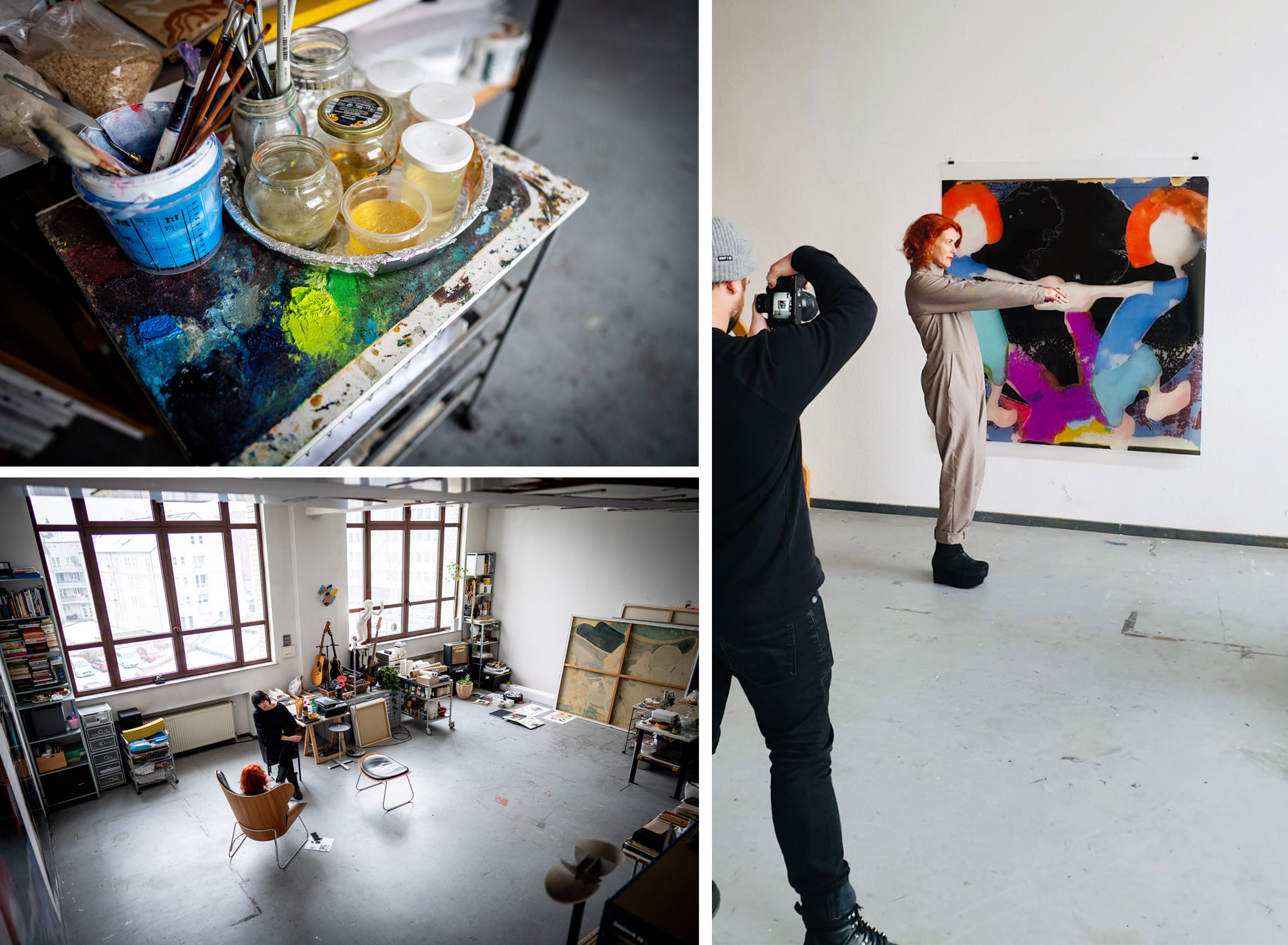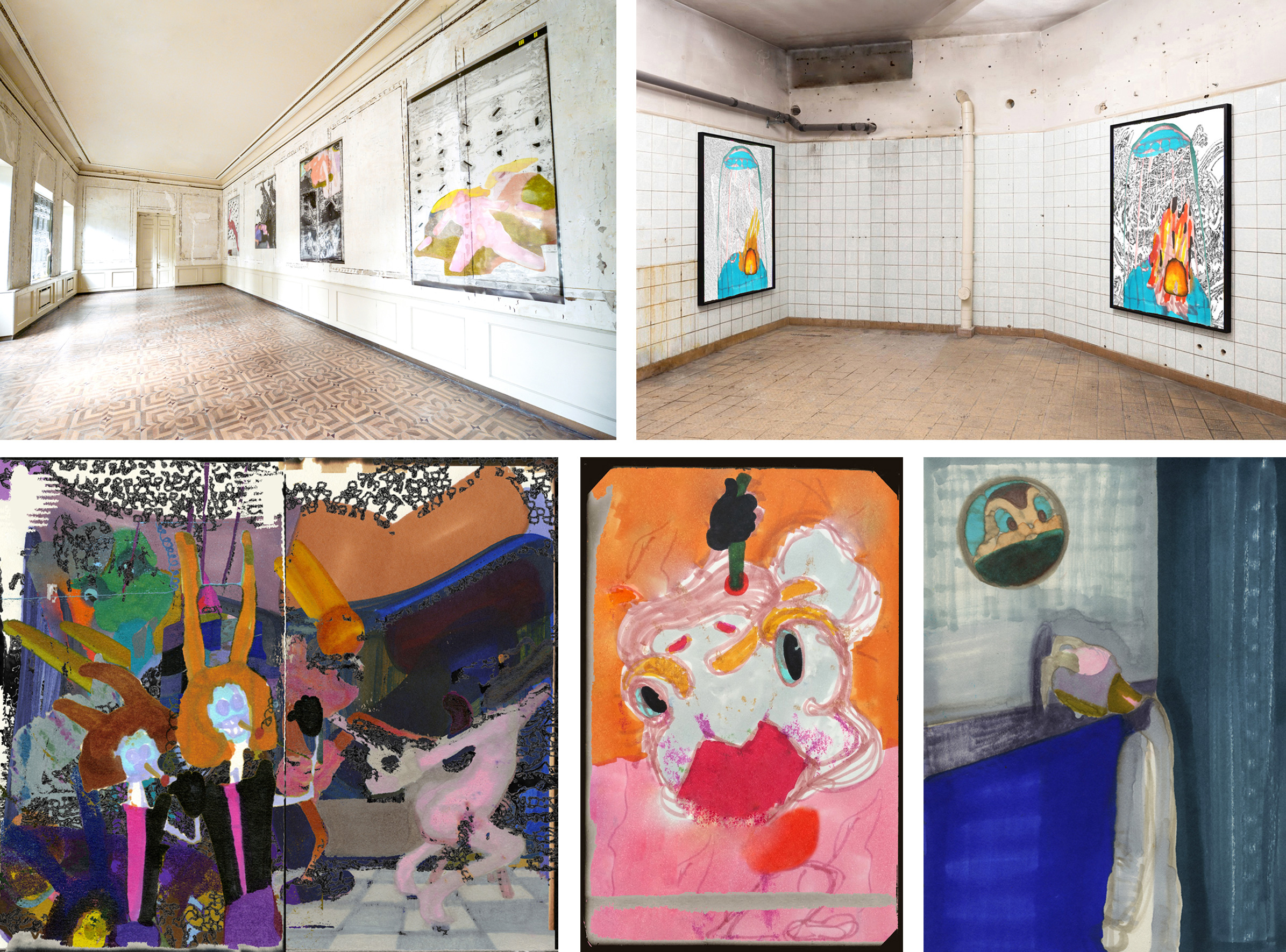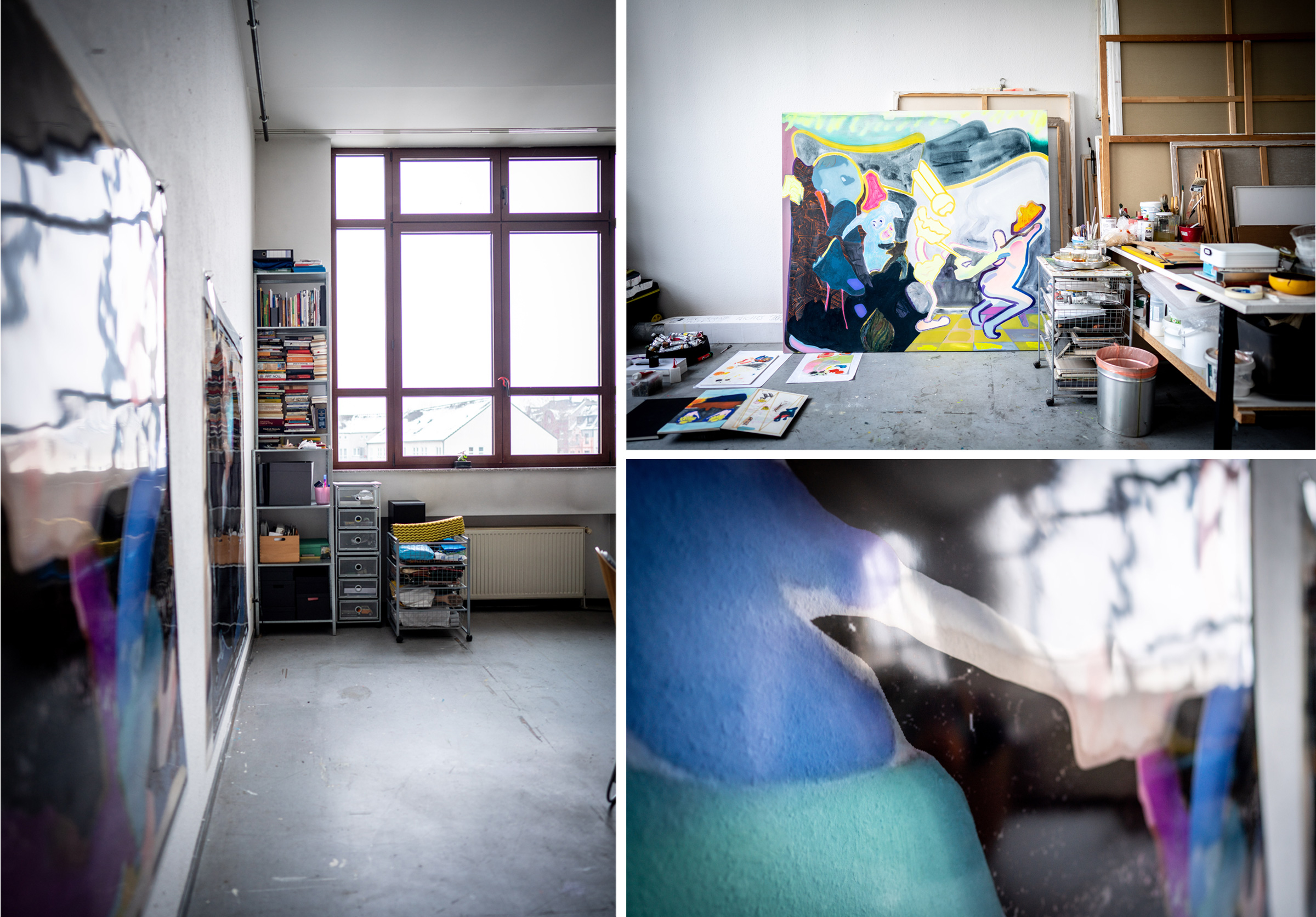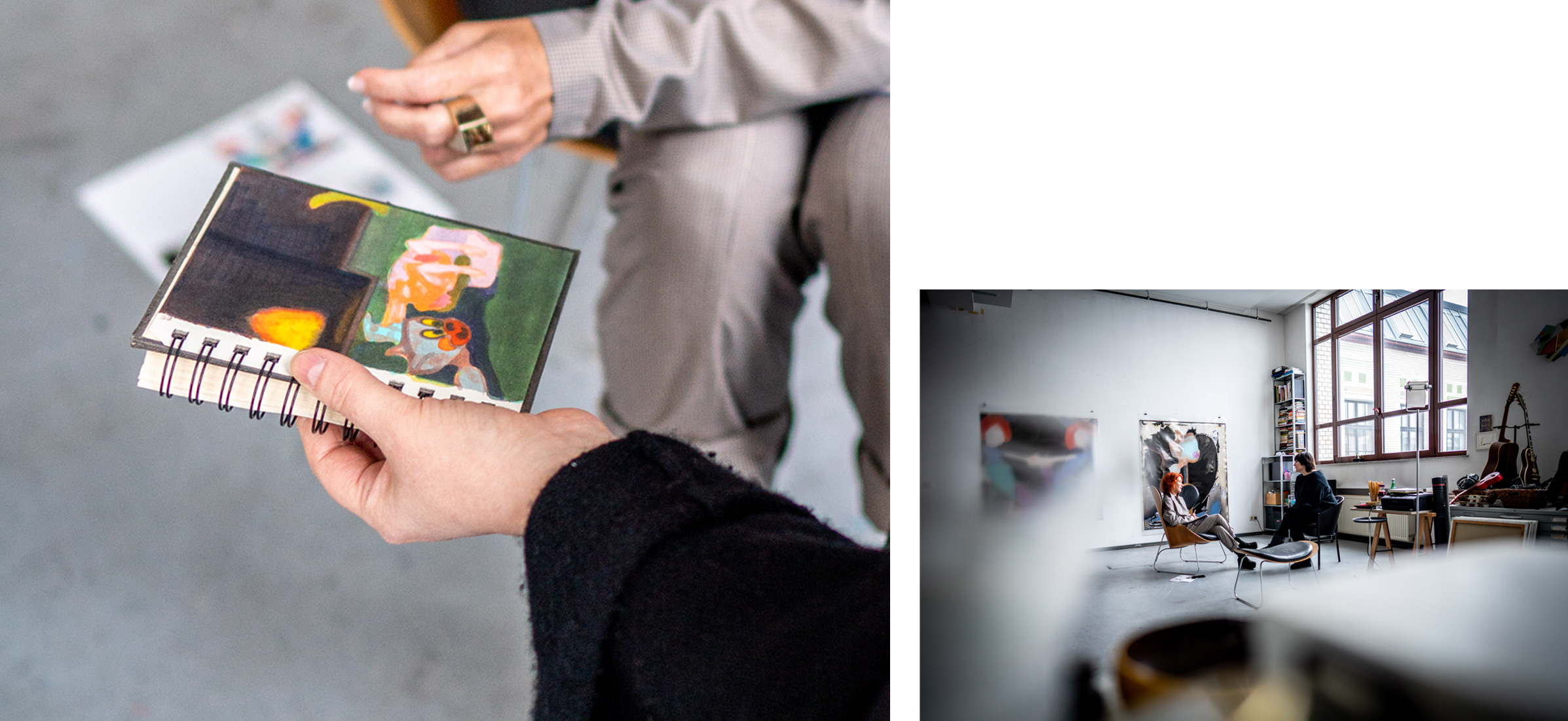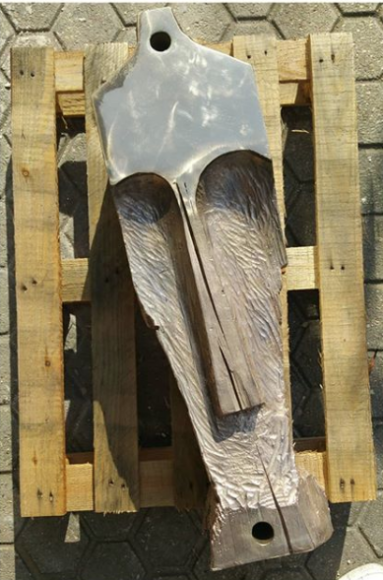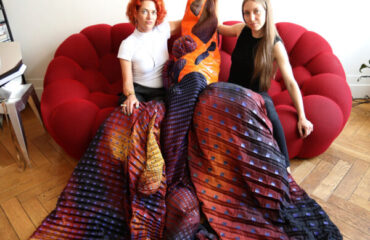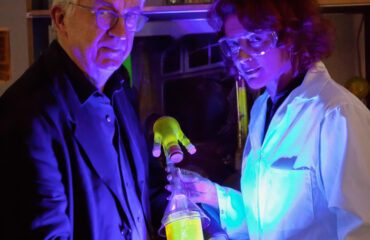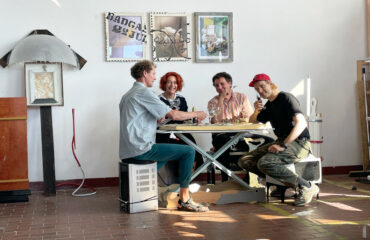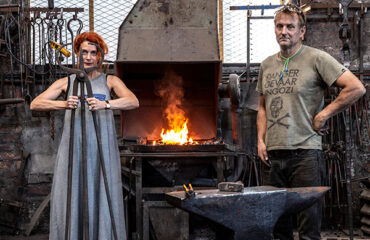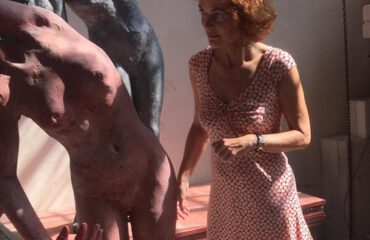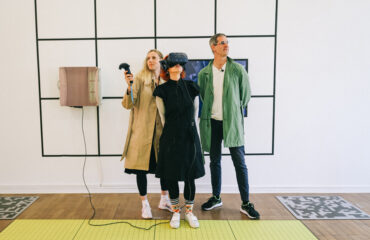Studiophotos: Markus Schwer
Düsseldorf. Visiting art fairs is exciting. At least in the beginning. Then, at some stage, it starts to become tiring because one can feel one’s concentration going. Many good art work is then simply missed, unless ….
Stop! Put on the brakes. A work of art or an entire presentation unfold a presence from which one cannot escape.
This happened in Vienna, during the presentation of works by Tamara K.E. at last year’s viennacontemporary. What happened? Large-format, Manga-like paintings on foil, some hanging on the wall, some leaning against it, in aluminium frames, one in front of the other. Then there is an indefinable sculpture, lying on the floor, attached by ropes, and finally this painting of the red-haired twins, holding hands. I was completely bowled over.
Views of installations of the presentation at viennacontemporary 2018, Galerie Beck & Eggeling
I was lucky. The artist was in town and we were able to arrange a meeting in her studio. These days, she lives and works mostly in New York, but, now and again, in her studio apartment in Düsseldorf, where we meet.
It is a beautiful loft apartment, recognisable by its impressively high ceilings and its large industrial windows. Working materials, canvasses and the furniture show that this is obviously an artist’s studio. One of the paintings on the wall stops me briefly in my tracks. There they are again …. the twins. I tell her my story from Vienna and ask the – to me – most important question: “How could you paint this painting without having ever met me before?” With a laugh, she replies: “It must have been artistic intuition”, gets her cell phone and takes the photo which shows me in interaction with my doubles.
Tamara K.E. is a German artist of Georgian extraction. As a teenager, she longed to go to Germany, where she studied at the Academy of Fine Arts in Munich and the Kunstakademie Düsseldorf. Still in the middle of her studies, she was discovered by the gallery owner Hans Mayer. From then on, everything moved quickly: A presentation at Art Cologne, the entry of her work to important art collections, museum exhibitions, exhibiting at the 50th Venice Biennale, invitation to the 1st Prague Biennale … and then? In 2019 – at the first pinnacle of her career – she packed her suitcase, left for New York and started from scratch.
Why?
“My life changed after my first presentation at a fair. Working subjectively, focussed on myself, was suddenly over. I was in the middle of the mechanism, which contradicted a certain creative irrationality. While the success was great, I started to feel that I needed new stimuli, that a period had come to an end.”
And did the new beginning works?
“Yes. Fortunately so. I was able to once again concentrate fully on my creativity, the people around me and everything that happened around me.”
It is time to have a closer look at her works. How and to what extent do they reflect these diverse, life-changing influences? We take a look at the prints of her works in her new catalogue and studio.
Nearly all motives show strong influences of Vintage Cartoon. The scenarios are lively, bright, often playful, excessive and feminine. They appear to be sequences of narratives. However, when trying to figure out the narrative, it gets difficult. Or more correctly – it is not possible. Although stylised figures or symbols are recognisable, they leave more questions than answers. In addition, the medium also influences the statement of the painting. A motif comes across differently if painted in oil and on canvas or printed on foil. While the manner in which the paint is applied to an oil painting tells us something about the mood during its creation, the flawless surface of the foil does not allow conclusions regarding the emotional state of the artists. And yet – these paintings too are alive. The painting seems to be in motion via the background shadows and the light reflections. Is it really a print?
“Yes, it is a print on slide film foil. However, this print is based on a drawing, which I then scan, segment and combine again to form new subjects.”
She takes out a small book and opens it. Each page shows a Tamara-typical drawing. An absolute treasure trove!
“Look at this figure here, for instance. You will find it again in the oil painting at the back there. But the narrative there is completely different, which is simply caused by the new composition of the painting and also the size. It keeps being a very exciting process for me watching the small figures change to a large format. What used to be subjective and protected gets lost. Suddenly, they become vulnerable.”
Correct. I can now also feel it.
“What gives you the idea for these figures and where does your obvious enthusiasm for the Comic style come from?”
“I grew up in Georgia during the Soviet-influenced period. Television did not show comics, one could only watch them at friends on video cassettes. I loved them! For once, not ideologically motivated subjects, but stories out of context, wild, chaotic and completely surreal. The figures in my images do not develop from already existing comic characters, but develop as random data. In this context, an obsessive, not clearly definable language is important. A language, which takes the dynamics of our cultural memory on board and therefore defies any final interpretation. Our world is an extremely loud and gaudy social factory which challenges us to reflect anew on the more recent, traumatising socio-political events and lift these off the fabric of a previous context. Once this has been achieved, we can move forwards. Perhaps I describe a situation, where we experience – sometimes hysterically, sometimes painfully – the imminent transition to the era of artificial intelligence the future of which is still unknown to us.
These thoughts are very clearly reflected in titles and motifs of the Farewelling Junkyard, Swanson in the Wide Open, Revisiting Fear, Bodies without Organs, The Randomizers etc. series. Also the choice of the medium.
“And this takes us to your works at viennacontemporary. Was the wood sculpture on the floor also yours? I could not see any connections to the other works.”
“Yes” (laughs), “It was not planned like that. This is a mask which I carved from wood according to prehistoric aesthetics and had worked into a swing. It was to be cast in bronze and was going to be suspended by ropes from the ceiling for the use of visitors at the art fair. My intention was to allow its massive physical presence to interact with the delicate transparency of the foil prints. I wanted the visitors to experience – in one cohesive flow of motion – the similarities of our past prehistoric cultural history and the digital age of the current and the future cultural history. I am interested in these multi-layered dependencies, the questions, which arise also in connection with technological developments that get faster and faster.”
Is it perhaps the multifacetedness of dependencies, which is reflected overall in the work of Tamara K.E., I wonder.
The figures in her images evolve from thoughts which arise from the reflection on personal encounters and experiences and her continuously changing view of the world. New figures or new image compositions are therefore dependent on multifaceted forms of the highly diverse reflections.
When put into form the final product emerges from an interaction of analogous and digital working methods. The creation and perception of new image compositions are therefore also dependent on technique and medium.
Overall, an artistic process, which experiments with the multifacetedness of dependencies, the interaction between man and technology and the interaction of the past, presence and future.
Perhaps to explore the ideas of tomorrow’s art as a kind of random data generator?
More Information
… about Tamara K.E.: https://www.instagram.com/t_k_e_/
… on the website of her gallery Beck&Eggeling: tamara_k_e
… about her catalogue: https://www.distanz.de/buecher/tamara-k.-e./fading-song-in-the-wide-open

